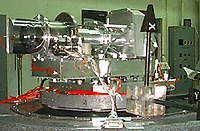
Imaging and Navigation Camera
NSSDC ID: 1999-003A-01
Mission Name: Stardust
Principal Investigator: Dr. Ray L. Newburn, Jr.
Description
The Stardust Imaging and Navigation Camera (NavCam) is designed to accurately determine the position of Comet P/Wild 2 during the approach and encounter for spacecraft navigation and then to obtain high resolution images of the nucleus. It is also designed to perform navigation and imaging during the asteroid Annefrank encounter. Much of the camera uses flight spares from the Voyager and Cassini imagers.
The camera is body-mounted on the spacecraft with a scan mirror set at 45 degrees to the optical axis. The mirror can sweep 180 degrees about the optical axis in a plane containing the velocity (ram) direction to allow tracking during the comet flyby. The camera lens is a six element Petzval design with a 202 mm focal length at a speed of f/3.5. An eight position filter wheel unfortunately became stuck two years into the mission. It fortuitously is stuck in the broadband optical navigation (OpNav) filter position, so the critical navigation function of the camera is not compromised. However, multi-spectral imaging will not be possible and the imaging of the nucleus will be at lower resolution than originally planned. The FWHM of the OpNav filter is about 1.6 pixels compared to 0.25 pixels for the high resolution filter. A 1024 x 1024 pixel CCD is used, giving a 0.06 milliradian/pixel instantaneous field of view, or a full frame field of view of 3.5 x 3.5 degrees.
The mechanical camera shutter can be set for exposures from 5 ms to 20 s, although for multiple exposures values as low as 3.35 ms occur. A calibration lamp is situated about 6 mm in front of the lens. In order to protect the scan mirror from "sand-blasting", the dust shield blocks the view of the mirror in the forward direction. A periscope is installed so the camera can view past the shield in the forward direction during the approach. The aluminum periscope mirror will be sand-blasted at this time, but the scan mirror will be protected. As the spacecraft approaches the nucleus and the direction to the nucleus increases to more than 19 degrees, the scan mirror rotates off the periscope for a direct view of the nucleus. The periscope has a mass of 2.5 kg, the rest of the camera including the scan mechanism has a mass of 9.5 kg. The system uses a maximum power of 18 W.
Some contamination of unknown origin has occurred in the system causing degradation of the images. Heating of the system through electrical heaters and direct sunlight on the radiator has removed most of the contamination, but a small amount remains, leaving a shallow halo of scattered light around each image.
Facts in Brief
Mass: 12.0 kg
Power (avg): 18.0 W
Funding Agency
- NASA-Office of Space Science Applications (United States)
Discipline
- Planetary Science: Small Bodies
Additional Information
Questions or comments about this experiment can be directed to: Dr. David R. Williams.
Personnel
| Name | Role | Original Affiliation | |
|---|---|---|---|
| Dr. Ray L. Newburn, Jr. | Lead Investigator | NASA Jet Propulsion Laboratory | newburn@scn1.jpl.nasa.gov |
Selected References
Newburn, R. L., Jr., et al., Stardust Imaging Camera, J. Geophys. Res., 108, No. E10, 8116, doi:10.1029/2003JE002081, 2003.

